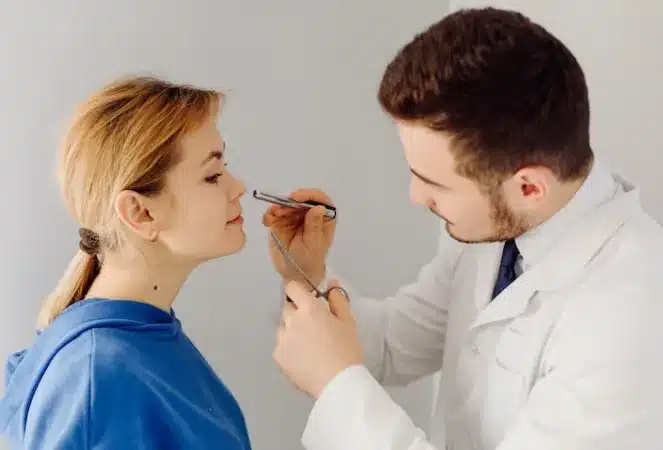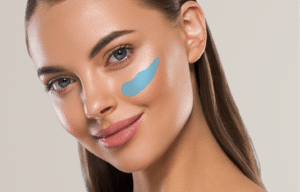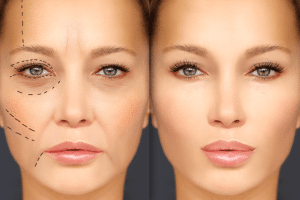Nasal surgery, specifically rhinoplasty for a bulbous tip, addresses cosmetic concerns related to nasal aesthetics. This specialized procedure focuses on reshaping the nasal tip to achieve a more refined and balanced appearance. Through cosmetic nose surgery, patients seek to enhance both the aesthetics and harmony of their facial features.
Rhinoplasty for Bulbous Tip
Rhinoplasty for bulbous tip refers to a specialized surgical procedure tailored to address and reshape a nose that has a rounded, bulb-like tip. Individuals with bulbous tips often feel that their nose appears too wide or lacks definition. This procedure aims to provide a more refined and harmonious look to the nose, enhancing the overall facial balance.
The nose plays a significant role in defining our facial features, and for many individuals, its shape or size may cause self-consciousness or dissatisfaction. Fortunately, advancements in cosmetic surgery have made it possible to alter the appearance of the nose through rhinoplasty, commonly known as a “nose job.”
Clinic contact number: +989371200167
Step-by-Step Procedure of Rhinoplasty for Bulbous Tip
Rhinoplasty for a bulbous tip typically involves several steps to reshape and refine the nasal tip. Here’s a general outline of the procedure:
Consultation
The process begins with a consultation with a board-certified plastic surgeon. During this appointment, the surgeon evaluates the patient’s nasal structure, discusses their goals and concerns regarding the bulbous tip, and assesses overall facial harmony to develop a personalized treatment plan.
Anesthesia
On the day of the procedure, the patient is placed under general anesthesia or local anesthesia with sedation to ensure comfort throughout the surgery.
Incisions
The surgeon makes small, inconspicuous incisions either inside the nostrils (closed rhinoplasty) or across the columella (open rhinoplasty). The choice of technique depends on the complexity of the case and the surgeon’s preference.
Tip Sculpting
With access to the nasal tip, the surgeon begins reshaping the cartilage and tissue to reduce the bulbous appearance. Techniques may include trimming excess cartilage, refining the nasal domes, and suturing the tip cartilages to create a more defined contour.
Cartilage Grafting (if needed)
In some cases, cartilage grafts may be harvested from the patient’s septum or ear to provide additional structural support or to build up areas of deficiency in the nasal tip.
Suturing and Closure
Once the desired reshaping is achieved, the surgeon carefully closes the incisions with sutures, ensuring minimal scarring and optimal healing.
Recovery and Follow-Up
After the procedure, the patient is monitored in a recovery area until they are ready to be discharged. The surgeon provides detailed post-operative instructions, including care for the nasal dressings, pain management, and activity restrictions. Follow-up appointments are scheduled to monitor healing progress and address any concerns.
Here’s what to expect during the recovery period and subsequent follow-up appointments:
Immediate Postoperative Care
Immediately after surgery, patients may experience some discomfort, swelling, and bruising around the nose and eyes. Pain medication and cold compresses can help manage these symptoms. It’s important to keep the head elevated and avoid strenuous activities to minimize swelling.
Nasal Dressings and Splints
The surgeon may place internal nasal splints and external nasal dressings to support the newly reshaped nasal structures and reduce swelling. These are typically removed within the first week after surgery during a follow-up appointment.
Follow-Up Appointments
Patients are scheduled for several follow-up appointments in the weeks and months following surgery. These appointments allow the surgeon to monitor healing progress, remove any remaining sutures or splints, and address any concerns or questions the patient may have.
Long-Term Results
Over time, swelling and bruising gradually subside, revealing the final results of the rhinoplasty. It may take several months for the nasal tip to fully settle into its new shape, and the patient can expect continued refinement of the nasal appearance over the following year.
It’s important for patients considering rhinoplasty for a bulbous tip to choose a qualified and experienced plastic surgeon who specializes in nasal surgery to ensure the best possible outcome. Additionally, realistic expectations and open communication with the surgeon are key to achieving satisfying results.
Ideal Candidates for Rhinoplasty for Bulbous Tip
The best candidates for rhinoplasty for a bulbous tip are individuals who:
- Are physically healthy and don’t have medical conditions that can impair healing.
- Have realistic expectations about the outcomes.
- Are you a non-smoker or willing to quit before and after the procedure?
- Are disturbed or self-conscious about the appearance of their bulbous nose tip?
Causes of a Bulbous Tip
A bulbous nasal tip is characterized by a rounded or overly prominent appearance at the end of the nose. Several factors contribute to the development of a bulbous tip, including genetics, nasal anatomy, and underlying structural issues. One common cause is an excess of soft tissue or cartilage in the nasal tip region, leading to a lack of definition and a rounded appearance. This excess tissue can result from inherited traits or nasal development during adolescence and adulthood.
Another contributing factor to a bulbous nasal tip is the shape and positioning of the lower lateral cartilages, which form the framework of the nasal tip. If these cartilages are overly broad, poorly positioned, or weakened, they can contribute to the bulbous appearance of the nasal tip. Additionally, certain conditions such as nasal trauma or previous nasal surgeries may alter the nasal anatomy and contribute to the development of a bulbous tip. In some cases, ethnic variations in nasal anatomy may also play a role, as certain ethnicities are predisposed to having a more bulbous nasal tip.
Furthermore, aging can exacerbate the appearance of a bulbous tip as the skin loses elasticity and the nasal tissues undergo changes over time. These changes can lead to the descent of the nasal tip and further accentuate its bulbous appearance. Understanding the underlying causes of a bulbous nasal tip is crucial for determining the most appropriate treatment approach, whether it be through non-surgical interventions such as injectable fillers or surgical rhinoplasty techniques aimed at reshaping and refining the nasal tip. Consulting with a qualified facial plastic surgeon or otolaryngologist can help individuals explore their options and develop a personalized treatment plan tailored to their unique needs and goals.

Can you fix a bulbous nose tip?
Yes, a bulbous nose tip can be corrected through various surgical and non-surgical interventions, depending on the severity of the condition and the individual’s aesthetic goals. Surgical correction typically involves rhinoplasty, specifically targeting the nasal tip to refine its shape and reduce its prominence. During rhinoplasty for a bulbous tip, techniques such as cartilage reshaping, tip suturing, and cartilage grafting may be employed to achieve a more defined and balanced nasal appearance. These procedures are tailored to the individual’s unique nasal anatomy and desired outcome, with the goal of creating a natural-looking result that harmonizes with other facial features.
In cases where the bulbous tip is mild or the individual prefers a non-surgical approach, injectable fillers can be used to temporarily camouflage or reshape the nasal tip. Hyaluronic acid fillers, such as Restylane or Juvéderm, can be strategically injected to add volume, definition, and symmetry to the nasal tip, providing a subtle improvement in appearance without the need for surgery. While non-surgical interventions offer temporary results and may require periodic touch-ups, they can be a suitable option for individuals seeking a less invasive approach or those who are not ready for surgery.
Ultimately, the decision to fix a bulbous nose tip depends on the individual’s preferences, concerns, and expectations. Consulting with a qualified facial plastic surgeon or otolaryngologist is essential to discuss available treatment options, assess the nasal anatomy, and develop a personalized treatment plan tailored to achieve the desired outcome. Whether through surgical rhinoplasty or non-surgical techniques, addressing a bulbous nose tip can enhance facial harmony and improve self-confidence, providing individuals with a more balanced and aesthetically pleasing nasal appearance.
Clinic contact number: +989371200167
The Pioneering Surgeons Shaping the Future of Bulbous Tip Rhinoplasty
Rhinoplasty for a bulbous tip, a specialized and intricate aspect of cosmetic surgery, demands not only exceptional skill but also a deep understanding of nasal anatomy and aesthetics. Prominent universities and their affiliated hospitals, such as Johns Hopkins University and Harvard Medical School, have been at the forefront of research and innovation in this field. Esteemed surgeons like Dr. Rod J. Rohrich from UT Southwestern Medical Center have contributed significantly to advancing techniques for refining the bulbous nasal tip, emphasizing the importance of individualized approaches for achieving natural, harmonious results.
The surgical community acknowledges their contributions through numerous publications and the development of advanced surgical techniques such as the “structural refinement” technique, which focuses on reshaping the lower nasal cartilages to achieve a more defined tip without compromising the nose’s functional aspects. In recent years, the most active entity in the realm of rhinoplasty for a bulbous tip has arguably been the Aesthetic Surgery Center, renowned for its innovative approach to nasal tip refinement. Statistics and figures emerging from such centers highlight a growing interest and demand for this specialized surgery, with a notable increase in procedures performed annually.
For instance, data from the American Society of Plastic Surgeons (ASPS) indicates a steady rise in rhinoplasty procedures, with a significant percentage dedicated to addressing the bulbous tip. The surgical community utilizes specialized terms such as “tip pasty,” “cephalic trim,” and “dome binding sutures” to describe the intricate techniques employed to sculpt and refine the nasal tip, underscoring the complexity and precision required in these procedures. This evolution in rhinoplasty practice not only enhances aesthetic outcomes but also promotes a deeper understanding of nasal structure and function, leading to improved patient satisfaction and results.

Age Consideration
Generally, surgeons recommend waiting until the nose has reached its adult size before considering rhinoplasty for bulbous tip. This typically happens around age 16 for girls and age 18 for boys. However, the decision also depends on the individual’s unique circumstances and physical development.
10 Benefits of Rhinoplasty for Bulbous Tip
- Enhanced facial symmetry.
- Boosted self-confidence and self-esteem.
- A permanent solution to a bulbous tip.
- Improved breathing in cases where the bulbous tip obstructed airways.
- Opportunity for simultaneous correction of other nasal imperfections.
surgery is a specialized procedure that aims to restore the form and function of the nose, often after trauma, cancer removal, or congenital abnormalities. This intricate surgical technique involves careful reshaping and reconstruction of the nasal construction to improve aesthetic appearance and breathing functionality.
- Advanced techniques result in minimal scarring.
- Enhanced overall facial appearance.
- Natural-looking results when performed by an experienced surgeon.
- Possibility of minimal downtime with rapid recovery techniques.
Positive psychological impact due to improved aesthetics.

You’ll have a dressing on your nose for the first 12 hours after the operation, and a splint held over your nose with tape for 7 days. NHS
10 Risks of Rhinoplasty for Bulbous Tip
- Post-operative infection.
- Breathing difficulties.
- Unsatisfactory cosmetic results.
- Scarring, especially with the open technique.
- Need for revision surgery.
- Prolonged swelling.
- Nosebleeds post-surgery.
- Numbness or tingling sensations.
- Asymmetry in the nose’s appearance.
- Adverse reactions to anesthesia.
What will results look like after bulbous tip rhinoplasty?
The results of bulbous tip rhinoplasty can vary depending on the individual’s anatomy, surgical technique, and aesthetic goals. However, in general, the primary goal of bulbous tip rhinoplasty is to create a more refined and balanced nasal appearance by reducing the size, projection, and roundness of the nasal tip. Following surgery, patients can expect to see a noticeable improvement in the shape and definition of the nasal tip, with a more proportional and harmonious relationship to the rest of the facial features.
Specifically, the nasal tip may appear more refined, sculpted, and defined, with a smoother contour and decreased bulbosity. The tip projection may also be adjusted to achieve better facial balance and symmetry. While individual results may vary, most patients report a significant enhancement in nasal appearance and overall facial harmony following bulbous tip rhinoplasty. It’s important to note that final results may take several months to fully manifest as swelling subsides, and the nasal tissues settle into their new shape.
Moreover, successful bulbous tip rhinoplasty should result in a natural-looking outcome that complements the individual’s facial features and preserves nasal function. While the goal is to achieve aesthetic improvement, it’s essential that the nasal tip maintains functionality, allowing for normal breathing and nasal airflow. Consulting with a skilled and experienced facial plastic surgeon who specializes in rhinoplasty is crucial for obtaining realistic expectations and achieving satisfactory results tailored to the individual’s unique anatomy and aesthetic preferences.

What is different about bulbous nose tip rhinoplasty?
Bulbous nose tip rhinoplasty is a specialized form of rhinoplasty aimed at addressing a prominent or rounded nasal tip. Unlike other types of rhinoplasties, which may focus on reshaping the entire nose or correcting functional issues, bulbous nose tip rhinoplasty specifically targets the tip region to create a more defined and balanced nasal appearance. This procedure involves techniques to reduce the size, projection, and roundness of the nasal tip, such as cartilage reshaping, tip suturing, and cartilage grafting.
One of the primary differences with bulbous nose tip rhinoplasty lies in the surgical approach, which emphasizes precision and attention to detail in sculpting the nasal tip while preserving nasal function and harmony with other facial features. Surgeons specializing in bulbous nose tip rhinoplasty possess advanced skills and expertise in refining the nasal tip to achieve natural-looking results tailored to the individual’s unique anatomy and aesthetic goals. Additionally, post-operative care and recovery may be slightly different for bulbous nose tip rhinoplasty compared to other rhinoplasty procedures, with specific instructions to support optimal healing and long-term outcomes for the nasal tip.
How much does a Bulbous Tip Rhinoplasty Cost?
The cost of a bulbous tip rhinoplasty, also known as a tip pasty, can vary significantly depending on the complexity of the procedure and the surgeon’s experience. Generally, the cost of a bulbous tip rhinoplasty ranges from $5,000 – $10,000.
Surgeons typically take into account several factors when determining the cost of a bulbous tip rhinoplasty, including the procedure’s complexity, the surgeon’s experience and reputation, the geographic location of the surgeon’s practice, and any additional fees, such as anesthesia and operating room costs.
In addition to the cost of the procedure itself, patients should also factor in additional costs, such as follow-up visits and any necessary medications. Furthermore, if the patient requires a revision procedure, it is important to factor in the cost of this additional procedure as well.
Overall, the cost of a bulbous tip rhinoplasty can vary significantly depending on a number of factors. As such, it is important for patients to speak with their surgeon to determine an accurate cost for the procedure.
Clinic contact number: +989371200167
Summary
When considering options like a brow lift or eyelid surgery, it’s essential to prioritize individual aesthetic goals and desired outcomes. While nasal surgery, also known as cosmetic nose surgery, focuses on reshaping the nose to improve nasal aesthetics, procedures like alar base reduction, nasal projection, and tip plasty are tailored to address specific nasal concerns. However, when contemplating facial rejuvenation beyond nasal reshaping, patients may explore complementary procedures such as a brow lift or eyelid surgery to enhance overall facial harmony.
Choosing between a brow lift or eyelid surgery depends on various factors, including the patient’s unique facial anatomy, desired results, and surgeon recommendations. A brow lift targets the forehead and upper facial area, addressing sagging brows and deep forehead lines, which can impact the appearance of the eyes and overall facial expression. On the other hand, eyelid surgery, also known as blepharoplasty, focuses on rejuvenating the eyelids by removing excess skin, fat, and muscle to create a more youthful and rested appearance. Ultimately, consulting with a qualified plastic surgeon will help individuals determine the most suitable approach to achieve their desired facial rejuvenation goals.
FAQs
1. What is a bulbous tip rhinoplasty?
– A bulbous tip rhinoplasty is a surgical procedure aimed at refining and reshaping the nasal tip to address a bulbous or rounded appearance. This procedure involves techniques to reduce the size, projection, and roundness of the nasal tip, creating a more balanced and aesthetically pleasing nasal profile.
2. Who is a suitable candidate for a bulbous tip rhinoplasty?
– Suitable candidates for bulbous tip rhinoplasty are individuals who are unhappy with the appearance of their nasal tip due to its bulbous or rounded shape. They may desire a more defined, refined nasal tip that harmonizes with the rest of their facial features. It’s essential for candidates to have realistic expectations and be in good overall health.
3. What techniques are used in bulbous tip rhinoplasty?
– Various surgical techniques may be employed during bulbous tip rhinoplasty, depending on the individual’s anatomy and desired outcome. Common techniques include cartilage reshaping, tip suturing, cartilage grafting, and tip narrowing. The specific approach used will be determined during the consultation with a qualified plastic surgeon.
4. What is the recovery process like after bulbous tip rhinoplasty?
– Recovery from bulbous tip rhinoplasty typically involves swelling, bruising, and discomfort around the nasal area. Patients may need to wear a nasal splint or dressing for the first week to support the healing process. Most of the swelling resolves within a few weeks, but final results may take several months to fully manifest. Patients are advised to follow post-operative instructions provided by their surgeon, including activity restrictions, medication use, and follow-up appointments.
5. Are there risks or complications associated with bulbous tip rhinoplasty?
– As with any surgical procedure, there are potential risks and complications associated with bulbous tip rhinoplasty. These may include infection, bleeding, asymmetry, scarring, and dissatisfaction with the results. It’s essential to discuss these risks with your surgeon and ensure that you understand the potential outcomes before undergoing surgery.
6. When can I expect to see the final results of bulbous tip rhinoplasty?
– While initial results may be visible once swelling subsides, it can take several months for the nasal tip to fully settle and for the final results of bulbous tip rhinoplasty to become apparent. Patience is key during the recovery process, as gradual changes occur over time, and the nose continues to refine in shape and appearance.
Nose reshaping (rhinoplasty) – NHS (www.nhs.uk)
Bulbous Tip Rhinoplasty (Nose Surgery): Causes, Procedure, Cost, and Recovery (pattmd.com)



